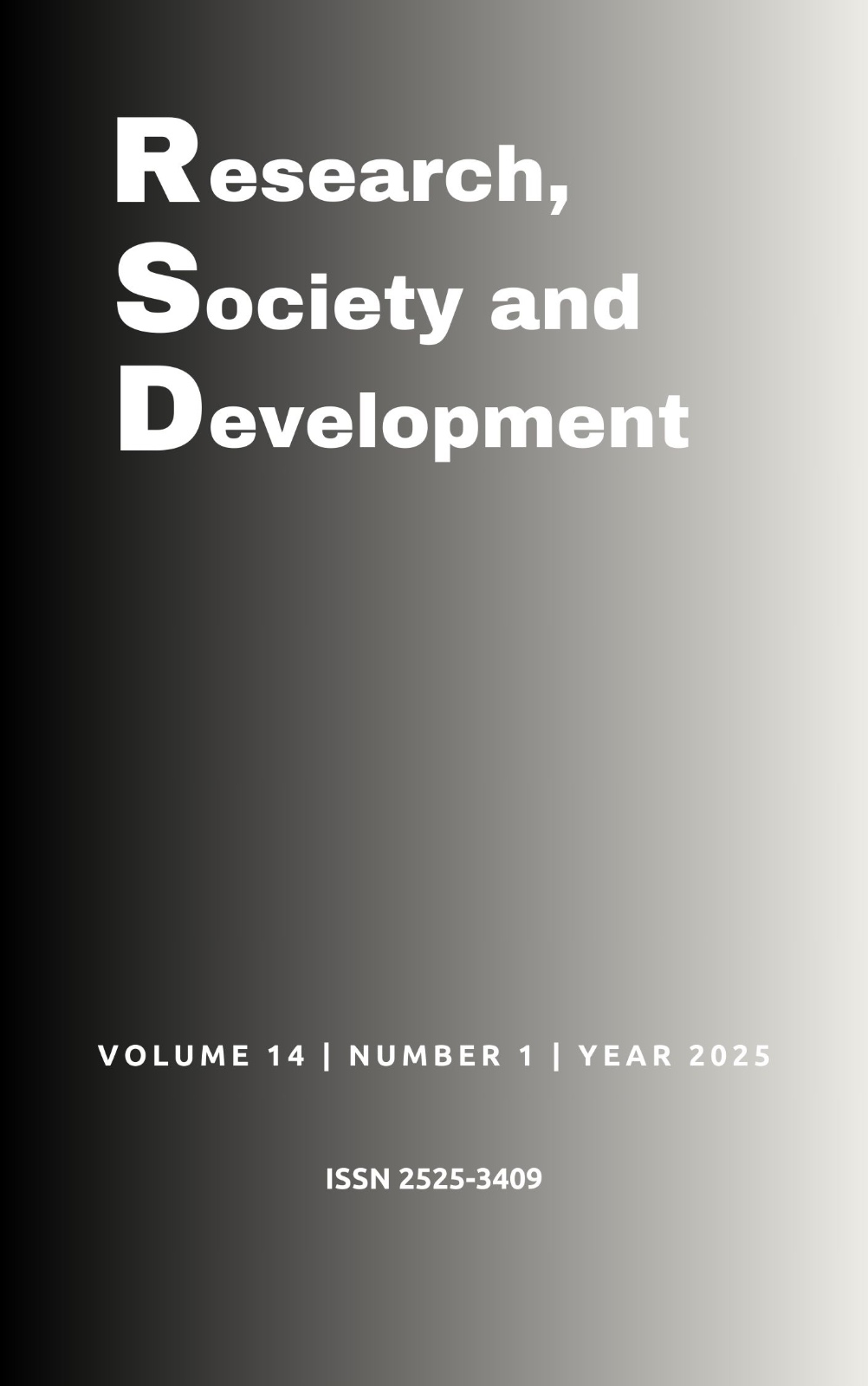Ensaios clínicos na técnica de osseodensificação para implantes dentários: Revisão de literatura
DOI:
https://doi.org/10.33448/rsd-v14i1.47897Palavras-chave:
Implante dentário, Osteotomia, Osseointegração.Resumo
Nesta revisão de literatura buscou-se reunir os trabalhos científicos de revisão sistemática e estudos clínicos em humanos, com a finalidade de melhorar o entendimento e obter uma avaliação mais objetiva das vantagens da técnica. O presente trabalho foi realizado após revisão bibliográfica no intervalo entre os anos de 2016 a 2024, por meio das plataformas de pesquisa pubmed, scielo e google scholar. Os artigos foram selecionados, principalmente, com estudos de revisão sistemática e ensaios clínicos. Na primeira fase do tratamento, o implantodontista realiza o preparo da loja óssea (osteotomia) onde será instalado o implante. A técnica de osseodensificação (OD) é um método de fresagem não extrativa porque o osso é condensado na loja óssea do preparo. A técnica de osteotomia convencional (SD) é considerada extrativa porque remove osso do local para inserir o implante. Diferentes brocas são utilizadas durante todo procedimento cirúrgico. Utilizada com metodologia e prática, a técnica de (OD) pode melhorar a osseointegração de implantes dentários em situações de pouco osso disponível. Propiciando a expansão de crista óssea e melhorando o processo de cicatrização devido a preservação do tecido ósseo no local do preparo.
Referências
Althobaiti, A. K. et al. (2023). A Comparative Assessment of Primary Implant Stability Using Osseodensification vs. Conventional Drilling Methods: A Systematic Review. Cureus, 15(10), e46841
Allorker, S. et al (2022). Effect of osseodensification on bone density and crestal bone levels: a split-mouth study. J contempo dent pract, 23(2), 162-168
Banerjee, S. et al. (2024). Comparative evaluation of ossedensification drilling versus conventional drilling technique on dental implant stability: a systematic review. The journal of indian prosthodontic society, 24(3), 225-232
Bergamo E. T. P. et al. (2021). Osseodensification effect on implants primary and secondary stability: Multicenter controlled clinical trial. Clin Implant Dent Relat Res, (23), 317–328
Brandao, T. L. et al. (2020). Osseodensification in atrophic maxila for subsequente installation of dental implants. Research, society and development, 9(8), e305985814
Bhalla, N., & Dym, H. (2021). Update on maxillary sinus augmentation. Dent Clin N Am, 197-210
Casarin, S. T. et al. (2020). Tipos de revisão de literature: considerações das editoras do Journal of Nursing and Health. Journal of Nursing and Health. 10(5). https://periodicos.ufpel.edu.br/index.php/enfermagem/article/view/19924
Daneshparvar, N et al (2023). The effects of clockwise and counterclockwise conventional and osseodensification drilling on the dimensions, density, and biomechanical properties of bone. Int J oral maxillofac implants, 38(1), 77-83
El-Kholey, Khalid E. et al. (2019). Does the Drilling Technique for Implant Site Preparation Enhance Implant Success in Low-Density Bone? A Systematic Review. Implant Dentistry 28(5), 500-509
Fereño-Cáceres A. et al. (2024). Primary stability with osseodensification drilling of dental implants in the posterior maxilla region in humans: A systematic review. Dent Med Probl, 61(4), 605–612
Fontes Pereira J., et al. (2023). Osseodensification: An Alternative to Conventional Osteotomy in Implant Site Preparation: A Systematic Review. J. Clin. Med, (12),7046
Gaspar, J. et al. (2024). Osseodensification versus lateral winfow technique for sinus floor elevation with simultaneous implant placement: a randomized clinical trial on patient-reported outcome measures. Clinical implant dentistry, 26(1), 113-126
Huwais, S., & Meyer, E. G. (2017). A Novel Osseous Densification Approach in Implant Osteotomy Preparation to Increase Biomechanical Primary Stability, Bone Mineral Density, and Bone-to-Implant Contact. The International Journal of Oral & Maxillofacial Implants, (32),1
Inchingolo, A. D. et al. (2021). The Effectiveness of Osseodensification Drilling Protocol for Implant Site Osteotomy: A Systematic Review of the Literature and Meta-Analysis. Materials, (14) 1147
Jarikian, S., Jaafo, M. H., & Al-Nerabieah Z. (2021) Clinical Evaluation of Two Techniques for Narrow Alveolar Ridge Expansion: Clinical Study. Int J Dentistry Oral Sci, 8(1),1337-1342
Khubchandani et al. (2024). Osseodensification: An Innovative Technique With Manifold Gains. Cureus, 16(5), e60255
Mattos, P. C. (2015). Tipos de revisão de literatura. Unesp, 1-9. Recuperado de https://www.fca.unesp.br/Home/Biblioteca/tipos-de-revisao-de-literatura.pdf
Mello-Machado RC. (2021). Clinical Assessment of Dental Implants Placed in Low-Quality Bone Sites Prepared for the Healing Chamber with Osseodensification Concept: A Double-Blind, Randomized Clinical Trial. Appl. Sci, (11), 640
Podaropoulos L. (2017). Increasing the Stability of Dental Implants: the Concept of Osseodensification. Balk J Dent Med , (21)
Padhye, N. M., Padhye, A. M., & Bhatavadekar, N. B. (2020). Osseodensification - a systematic review and qualitative analysis of published literature. Journal of Oral Biology and Craniofacial Research, (10), 375–380
Pereira A. S et al. (2018). Metodologia da pesquisa científica. (free e-book). Editora UAB/NTE/UFSM
Rother, E. T. (2007). Revisão sistemática x revisão narrative. Acta Paul. Enferm. 20(2). https://doi.org/10.1590/S0103-21002007000200001
Stacchi, C et al. (2023). Changes in implant stability using different site preparation techniques: Osseodensification drills versus piezoelectric surgery. A multi-center prospective randomized controlled clinical trial. Clin Implant Dent Relat Res. (25), 133-140
Tengfei Fan et al. (2016). Short implants (5 to 8mm) versus longer implants (+ 8mm) with sinus lifting in atrophic posterior maxilla: a meta-analysis of RCTs. Clinical implant dentistry, 19(1), 207-215
Xinbo Yu et al. (2022). Primary implant stability based on alternative site preparation techniques: a systematic review and meta-analysis. Clinical implant dentistry, 24(5), 580-590
Publicado
Edição
Seção
Licença
Copyright (c) 2025 Renato Cezar Boni

Este trabalho está licenciado sob uma licença Creative Commons Attribution 4.0 International License.
Autores que publicam nesta revista concordam com os seguintes termos:
1) Autores mantém os direitos autorais e concedem à revista o direito de primeira publicação, com o trabalho simultaneamente licenciado sob a Licença Creative Commons Attribution que permite o compartilhamento do trabalho com reconhecimento da autoria e publicação inicial nesta revista.
2) Autores têm autorização para assumir contratos adicionais separadamente, para distribuição não-exclusiva da versão do trabalho publicada nesta revista (ex.: publicar em repositório institucional ou como capítulo de livro), com reconhecimento de autoria e publicação inicial nesta revista.
3) Autores têm permissão e são estimulados a publicar e distribuir seu trabalho online (ex.: em repositórios institucionais ou na sua página pessoal) a qualquer ponto antes ou durante o processo editorial, já que isso pode gerar alterações produtivas, bem como aumentar o impacto e a citação do trabalho publicado.


